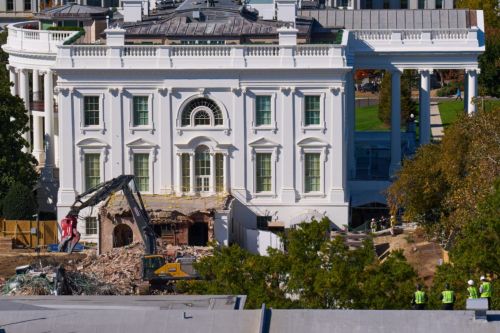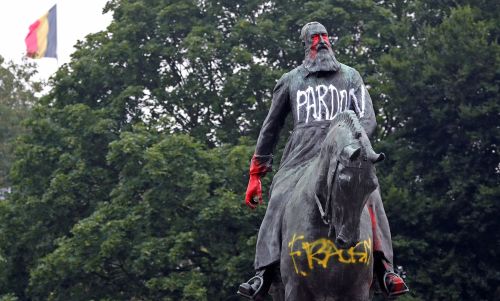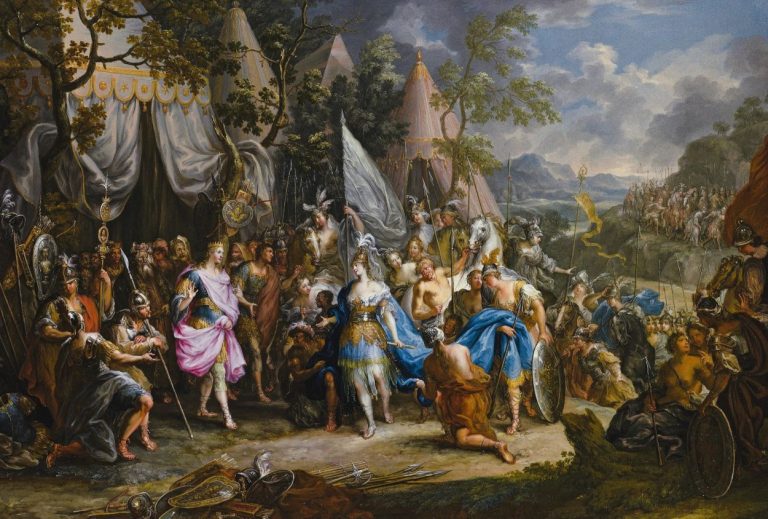

Stone cannot conceal truth forever. Time has a way of turning monuments into mirrors, reflecting the morality of those who built them and those who inherit them.

By Matthew A. McIntosh
Public Historian
Brewminate
Introduction: Built Grandeur, Public Space, and Contested Memory
When President Donald Trump unveiled his planned renovations to the White House, including a gilded ballroom, the marble-clad transformation of Abraham Lincoln’s private bathroom, all after demolishing the East Wing, he did more than alter an old building. He reshaped a national symbol. The project has wrapped historical reverence in unmistakable opulence: gold leaf, imported marble, and custom chandeliers. It is an endeavor awash in spectacle and self-mythology of a man who wants to be king.
A century earlier, an actual king, Leopold II of Belgium, undertook his own architectural crusade, covering Brussels with palaces and monuments paid for by the brutally-obtained wealth of the Congo Free State. His vision of imperial grandeur turned urban space into a stage for authority and amnesia, a way to sanctify exploitation with marble façades. As statues of Leopold have been defaced or removed across Belgium in recent years, the parallels become harder to ignore.
Both men, separated by time and empire, used architecture to tell stories about power, permanence, and identity. In each case, the stones themselves became political. What follows explores how Trump’s gilded renovations echo Leopold II’s monuments in their quest to immortalize authority through grandeur, and what those choices reveal about how nations remember, or refuse to remember, the costs of their own mythology.
Leopold II’s Monuments and Palaces: Empire, Memory, Architecture

When King Leopold II ascended the Belgian throne in 1865, he inherited a small constitutional monarchy but imagined an empire that would rival Britain’s. What he lacked in territory, he pursued through image. Belgium became his canvas, and architecture his instrument of myth-making. Between 1865 and 1909, Leopold oversaw a transformation of Brussels that included the Cinquantenaire Arch, the Africa Palace in Tervuren, and the Royal Galleries at Ostend, all monumental statements of imperial wealth and divine right. These were not public works in the civic sense but propaganda in stone, meant to persuade Belgians that their prosperity and prestige were born of benevolent empire rather than ruthless exploitation.
The funds for this grandeur flowed from the Congo Free State, a vast personal possession that Leopold ruled from 1885 to 1908. Behind the façades of his triumphal architecture lay a humanitarian catastrophe. Millions of Congolese were killed or mutilated under a regime of forced labor that extracted ivory and rubber for European profit. Contemporary missionaries and journalists documented the brutality, but in Brussels the narrative remained gilded. The marble halls of the Africa Palace displayed exotic trophies and murals depicting loyal Africans serving their European benefactors. Architecture thus became a shield, a way to aestheticize violence and mute moral reckoning.
Today, the afterlives of Leopold’s monuments continue to divide Belgium. Statues of the king have been vandalized, removed, or relocated to museums as the country confronts its colonial legacy. During the 2020 wave of protests, the image of Leopold II, long unchallenged, became a focal point of public outrage and historical re-examination. A commission established by the Belgian parliament later recommended contextualizing remaining statues and converting colonial museums into spaces of truth-telling rather than glorification. The struggle over these structures underscores how architecture can embody denial as much as memory.
Yet even amid condemnation, the palaces remain standing, still magnificent, still visited. Their endurance raises uncomfortable questions about beauty, guilt, and forgetting. Can a society preserve monuments of exploitation without perpetuating their message? Or must it, as some advocates argue, melt them down into memorials for the victims they conceal? The debate is not merely about statues or façades, it is about who gets to define national identity through stone and space. And as the next section shows, that question is not confined to nineteenth-century Belgium.
Trump’s White House Transformations: Golden Ballrooms, Bathrooms, and Territory
Trump’s approach to the White House was never one of stewardship alone; it was a continuation of branding. Renovations have become a form of political theater, reimagining the presidential residence as a monument to luxury and control. One seemingly small but striking example is the Lincoln bathroom renovation, a project that replaced century-old fixtures with imported marble and gold accents. It is an act of aesthetic nationalism that replaced historical authenticity with spectacle, mirroring Trump’s preference for grandeur over subtlety.
The project is part of a broader transformation that extends beyond decor. Trump ordered the demolition of the East Wing to make way for new entertainment and ceremonial spaces, including what staff informally dubbed the “golden ballroom.” It was designed for state dinners, political galas, and donor events, spaces where political power and personal image could merge seamlessly. This remodeling was less about function than narrative: the president as builder, restorer, and patriarch of a reborn American palace.
Yet, as with Leopold II’s palaces, these projects carried symbolic weight far beyond architecture. In reshaping the White House, Trump has recast the presidency’s physical space into an extension of his populist mythology, a stage upon which strength, wealth, and heritage can be performed. It is not just marble replacing porcelain; it is ideology replacing memory. The same walls that once bore the weight of Lincoln’s grief and Roosevelt’s deliberations now reflect the glint of gold leaf and a chandelier.
To some observers, these changes represent the convergence of personal vanity and political purpose. Like the monuments of empire, Trump’s renovations seek to make permanence out of personality. The palace aesthetic (gold, marble, symmetry) communicated dominance and grandeur, inviting awe rather than introspection. And in that aesthetic choice lies the connection to Leopold II: both men understood that stone and light can seduce the public into forgetting the costs of the power they enshrine. Or, in Trump’s case, wrapping himself in it.
Comparative Analysis: Architecture, Memory, Power

The parallels between Leopold II’s palaces and Trump’s presidential renovations are not merely aesthetic. Both used architecture to craft narratives of authority, to transform buildings into embodiments of political myth. For Leopold, imperial structures celebrated Belgium’s ascendancy through colonial domination; for Trump, the White House’s transformation projects an image of renewal, strength, and timeless wealth. In both cases, architecture is a language of legitimacy, asserting that grandeur itself could substitute for moral grounding.
Each also used construction as a form of historical authorship. Leopold wrote his version of empire in marble, embedding his image in arches, boulevards, and museums. Trump similarly seeks to inscribe his presidency into the nation’s physical memory, restoring and renaming rooms, commissioning opulent spaces that bear his unmistakable aesthetic. In both, the act of building became synonymous with rewriting history: monuments and renovations not as preservation but as revision.
Yet their contexts reveal crucial divergences. Leopold’s projects were funded by overseas exploitation and designed to mask atrocities beneath cultural refinement. Trump’s renovations, by contrast, draw from domestic funds and are aimed not at concealing empire but at glorifying leadership through spectacle. The Belgian king built palaces to sanctify imperial conquest; the American president is building ballrooms to sanctify himself. The difference lies less in intention than in scale as both wielded architecture to mythologize power and frame it as destiny.
The reactions to these projects also mirror one another across centuries. Leopold’s statues now face removal, his palaces reevaluated through the lens of historical justice. Trump’s modifications have provoked public debate over taste, transparency, and the line between private branding and public heritage. In both nations, the question persists: when leaders imprint their ambitions on the architecture of state, do those spaces still belong to the people, or do they become monuments to the rulers themselves?
Ultimately, architecture serves as a mirror of national conscience. Leopold II’s marble halls once embodied pride but now stand as uneasy relics of cruelty. Trump’s White House, refitted in gold and stone, may one day evoke similar reflection, not for its beauty, but for what it tried to preserve and what it attempted to erase. Across eras and continents, the struggle over monuments and memory remains the same: who decides what is worth remembering, and at what moral cost?
Why These Built Spaces and Memories Matter Now
The power of architecture lies not only in what it commemorates, but in what it conceals. In Belgium, Leopold II’s monuments were long treated as symbols of national pride, testaments to vision and modernity. Only in recent decades have they been recognized for what they also are: silent accomplices in a narrative that erased colonial violence. Statues once garlanded in celebration now bear graffiti calling him “assassin” and “colonizer.” The Royal Museum for Central Africa in Tervuren, itself founded by Leopold as a colonial showcase, has since re-curated its exhibits to confront that legacy directly. What was once glorification is being reframed as accountability.
In the United States, Trump’s architectural imprint is newer but no less revealing. The marble and gold of his renovations already invite debate over whether the presidency should project humility or splendor. The redesigned spaces symbolize excess and a disregard for historical authenticity, a gilded echo of his private brand carried into public heritage. The tension between preservation and performance has become a national conversation about who controls collective memory and how it should look when embodied in the most symbolic building in America.
These architectural choices carry real consequences. They shape how citizens experience history, not through textbooks, but through the spaces where history lives. When visitors walk through Leopold’s Cinquantenaire Arch or Trump’s ballroom, they are not only seeing architecture but absorbing ideology. Monuments and renovations alike communicate values about power, virtue, and belonging. They tell citizens whether their history is to be confronted or adorned.
For historians and writers, this raises a responsibility that goes beyond aesthetic critique. The task is to interpret, not just to describe stone and marble, but to reveal what those materials say about moral memory. Architecture becomes evidence, and preservation becomes an ethical question. To study a monument is to ask what it celebrates and what it silences. The debates over Leopold II’s statues and Trump’s renovations show that every society eventually faces the same reckoning: whether its monuments serve the truth or merely decorate its illusions.
Reflections and Propositions for Public Memory and Architecture
The reckoning with architecture and memory must begin with humility, an acknowledgment that every monument is a story told by those in power. In Belgium, commissions have debated whether to remove, reinterpret, or relocate statues of Leopold II. Some argue for contextualization, turning monuments into educational tools rather than objects of worship. Others call for erasure, insisting that the king’s legacy is too stained by atrocity to deserve public display. Both positions reveal a deeper struggle: how to balance beauty and guilt, heritage and justice, without resorting to historical amnesia.
In the United States, Trump’s renovations pose a different kind of challenge. They are not relics of a vanished empire but living alterations to a working institution. The question is not whether to tear them down, but how to interpret them, what story they will tell future generations about power, taste, and identity in early twenty-first-century America. The golden ballroom and marble bathroom are unlikely to be reversed (though a new president, if there is one, can repurpose it), but they can be documented, studied, and critiqued as artifacts of a political moment that blurred the line between presidency and persona. In that sense, the White House has joined the lineage of palaces that speak as much about their builders as their nations.
Both Belgium and the United States confront the same underlying paradox: societies that celebrate democracy often preserve symbols of hierarchy. Leopold’s statues enshrined a king who ruled by decree over millions he never met. Trump’s renovations exalt a presidency increasingly defined by personal loyalty rather than institutional restraint. In both cases, architecture became a means of projecting permanence amid political fragility, a way to make power feel inevitable by casting it in stone and gold.
The way forward lies not in destruction, but in illumination. Monuments and buildings can be reclaimed as instruments of learning rather than domination. Museums that once glorified empire can now expose its violence; official residences that flaunt excess can remind citizens of the dangers of personality cults. Context does not absolve; it educates. Reinterpretation, when done honestly, turns architecture into dialogue rather than dogma.
For historians, artists, and citizens alike, the task is to look again (at every statue, hall, or gilded wall) and ask whose memory it serves. The legacy of Leopold II and the renovations of Donald Trump both demonstrate that architecture is never neutral. It either confronts truth or conceals it. The moral question is not what we build, but what we choose to see when the light strikes the marble.
Conclusion
Across continents and centuries, the architecture of power reveals a shared language: gold, marble, and grandeur as stand-ins for permanence and legitimacy. Leopold II built his palaces to immortalize empire; Trump reshaped the White House to immortalize himself. Both believed that beauty could sanctify ambition, that if the columns were tall enough and the ceilings gilded enough, history would forgive the rest. But stone cannot conceal truth forever. Time has a way of turning monuments into mirrors, reflecting the morality of those who built them and those who inherit them.
The question is not whether such structures endure, they almost always do, but what they mean once the applause fades. Belgium now debates whether to melt its statues of Leopold into memorials for his victims. America may one day debate how to interpret the ballroom and marble bathrooms that symbolize Trump’s vision of leadership. In both cases, the reckoning will not be about architecture alone but about the stories a nation tells itself when it looks at the edifices of power and asks, “Who were we trying to be?”
History does not reside only in archives; it lives in the buildings that outlast their makers. Whether palace or presidency, every monument is a confession in stone. Leopold II’s arches and Trump’s gilded renovations remind us that power always seeks to be remembered as noble, even when it is not. The task of history (your task, and mine) is to ensure that memory remains stronger than marble.
Originally published by Brewminate, 11.04.2025, under the terms of a Creative Commons Attribution-NonCommercial-NoDerivatives 4.0 International license.


